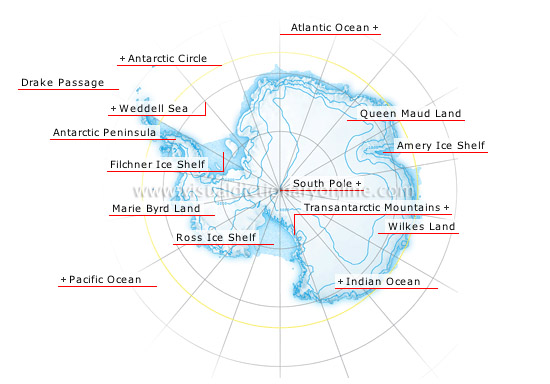Antarctica
The only uninhabited continent (5 million mi2), located inside the south polar circle; 98% of its surface is covered with an ice cap. Antarctica holds 90% of the Earth’s freshwater reserves.
Transantarctic Mountains 
Mountain chain that is an extension of the Andes Cordillera in South America; its peaks reach heights of more than 13,000 feet.
Ross Ice Shelf 
Immense ice shelf beginning at the edge of the continent’s southern slope.
Marie Byrd Land 
Region at an altitude of over 6,500 feet.
Filchner Ice Shelf 
Fed by adjacent continental ice sheets and by local precipitation; it borders the Weddell Sea.
Antarctic Peninsula 
Extends far beyond the polar circle and includes several mountain systems; parts that crumble away from its tip form small islands.
Drake Passage 
Almost 560 mi wide, it separates Tierra del Fuego from Antarctica and connects the Atlantic to the Pacific; its currents are very powerful.
Antarctic Circle 
Parallel of latitude at 66°34' S that marks the polar zone, where days and nights last 24 hours during solstices.
Indian Ocean 
From the polar circle to the continent, this ocean is called the Antarctic.
Wilkes Land 
Region of the Antarctic continent that takes its name from a 19th-century American mariner and explorer.
Amery Ice Shelf 
Its immense size makes it one of the world’s most remarkable ice shelves.
Queen Maud Land 
Oldest and largest part of Antarctica, Queen Maud Land also forms its continental shelf.
South Pole 
Point of the terrestrial surface at the southern extremity of the Earth’s axis of rotation; the Norwegian Amundsen and his expedition first reached it in 1911.
Atlantic Ocean 
From the polar circle to the continent, this ocean is called the Antarctic.
Weddell Sea 
Sea northwest of Antarctica, partly delimited by the Antarctic Peninsula; more than half of its surface is covered with pack ice.
Pacific Ocean 
The world’s largest ocean (69 million mi2), the Pacific covers 30% of the Earth’s surface, more than all of the continents put together.













